flat tire AUDI A5 2015 Owner´s Manual
[x] Cancel search | Manufacturer: AUDI, Model Year: 2015, Model line: A5, Model: AUDI A5 2015Pages: 264, PDF Size: 66.83 MB
Page 121 of 264
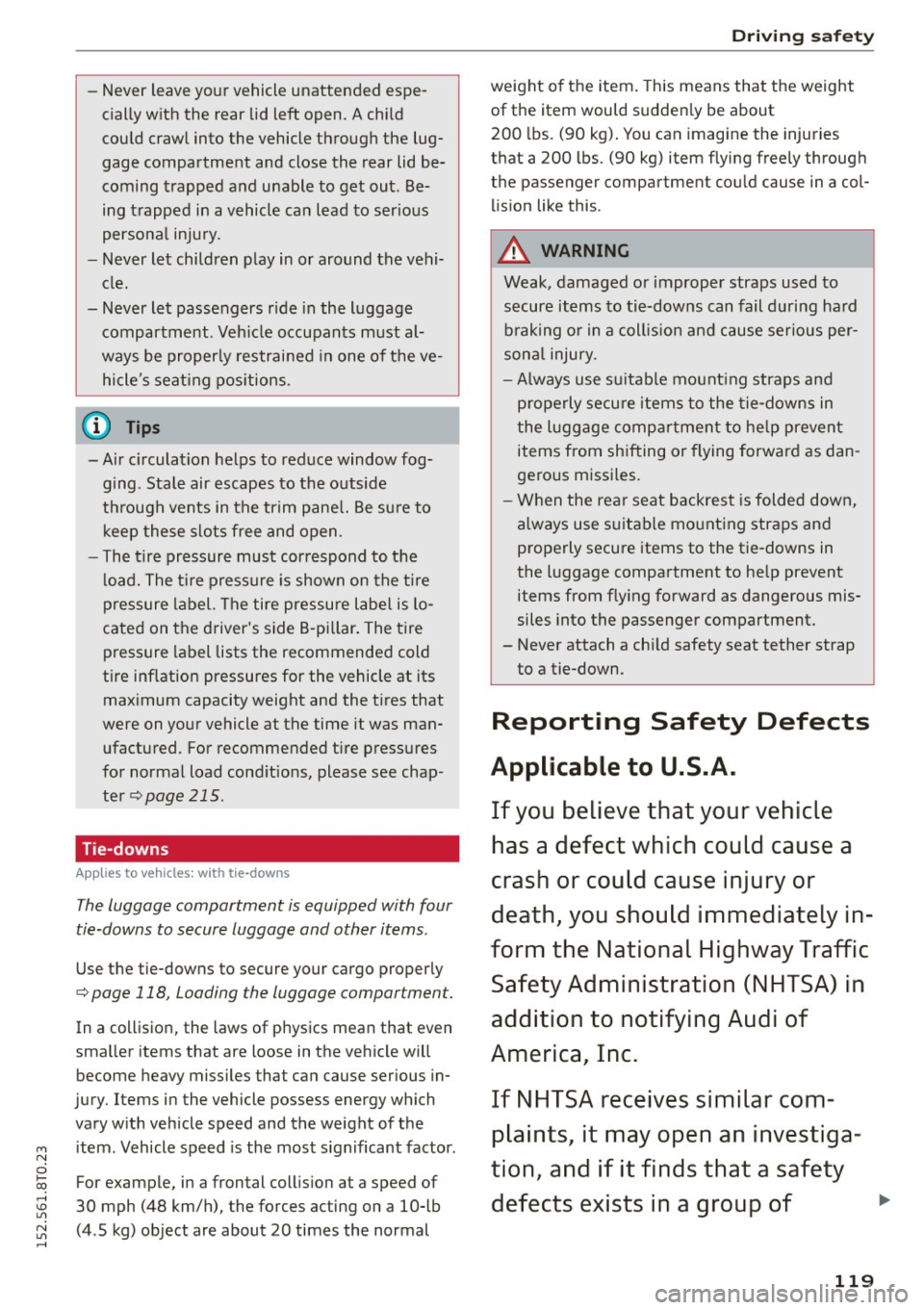
-Never leave your vehicle unattended espe
cially w ith the rear lid left open. A chi ld
could crawl into the vehicle through the lug
gage compartment and close the rear lid be
coming trapped and unable to get out . Be
ing trapped in a vehicle can lead to serious
persona l inju ry.
- Never let children play in or around the vehi
cle.
- Never let passengers r ide in the luggage
compartment . Veh icle occupants m ust al
ways be properly restrained in one of the ve
hicle's seat ing pos itions.
-Air c irculation helps to reduce window fog
ging . Stale air escapes to the outside
th rough vents in the trim pane l. Be su re to
k eep the se slots free and open.
- The t ire pressure must correspond to the
l oad. The t ire pressure is shown o n the tire
pres sure label. T he tire pressure l abe l is lo
cated on the d river 's side B-pi llar . The t ire
pressure label lists the recommended cold
tire inflation pressures for the vehicle at its
max imum capacity weight and the t ires that
were on your vehicle at the time it was man
ufactured. For recommended tire pressures
for normal load cond it ions, please see chap
te r
c:> page 215.
Tie-downs
App lies to vehicles: wit h tie-downs
The luggage compartment is equipped with four
tie-downs to secure luggage and other items .
Use the tie-downs to secure your cargo proper ly
¢ page 118, Loading the luggage compartment.
In a collision, the laws of phys ics mean that even
sma ller items that are loose in the vehicle w ill
become heavy missiles that can cause serious in
jury. Items in the vehicle possess energy which
va ry w ith vehicle speed and the weight of t he
item . Vehicle speed is the most s ignificant factor .
For example, in a frontal collis ion at a speed of
30 mph (48 km/h), the forces acting on a 10-lb
(4 .5 kg) object are about 20 times the normal
Dr ivin g s afet y
weight o f the item . This means that the weight
of the item would sudden ly be about
200 lbs. (90 kg) . You can imagine the injuries
that a 200 lbs. (90 kg) item flying freely through
the passenger compartment co uld cause in a col
li sion like this .
A WARNING
-Weak, damaged or imprope r straps used to
secure it ems to tie-downs can fail d uring ha rd
b raking o r in a coll is ion and cause seriou s per
son al injury .
- Always use s uitable mount ing straps and
p roperly se cu re i tems to the tie-downs in
the l ugg age compa rtment to he lp prevent
items from sh ifting or flying forward as dan
ge rous missi les.
- W hen the rear seat backrest is folded down,
always use s uita ble mo unting straps an d
properly secu re items to the tie-downs in
the l uggage compa rtment to he lp prevent
items from f ly ing forward as dangerous mis
siles into the passenger compartment.
- Never attach a chi ld safety seat tether strap
to a tie-down.
Reporting Safety Defects
Applicable to U.S.A.
If you belie ve that your vehicle
has a defect which could caus e a
crash or could cause injury or
death, you should immediately in
form the National Highway Traffic
Safet y Adm ini stration (NHTSA) in
addition to notifying Audi of
America, Inc.
If NHTSA re ceives simila r com
pl aint s, it may open an inve stig a
tion , and if it find s that a safety
d efe cts e xis ts in a group of ""
119
Page 184 of 264
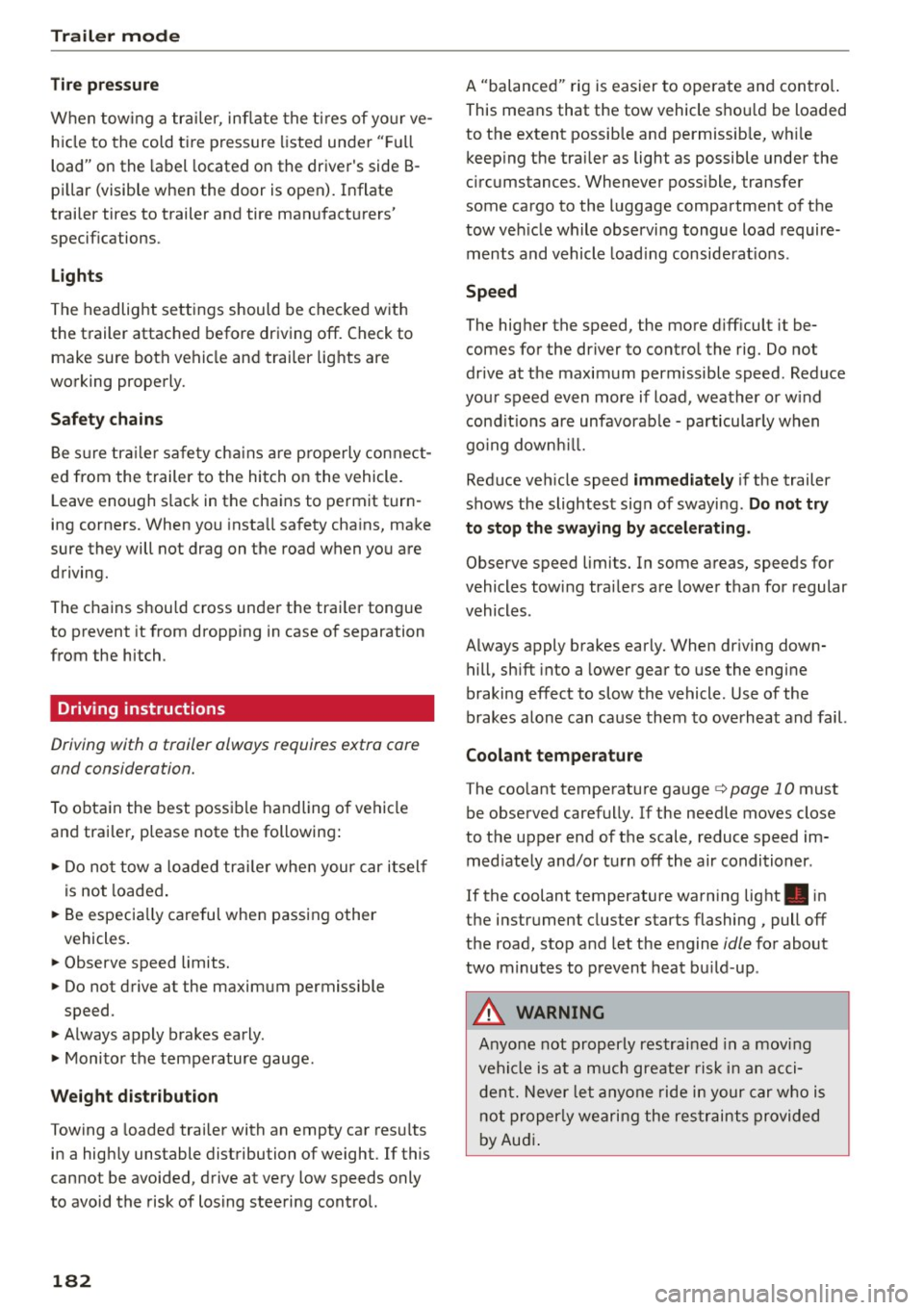
Trailer mode
Tire pressure
When tow ing a trailer, inflate the tires of your ve
hicle to the cold tire pressure listed under " Full
load" on the label located on the driver's side B
pillar (visible when the door is open). Inflate
trailer tires to trailer and tire manufacturers'
specifications.
Lights
The headlight settings should be checked with
the trailer attached before driving off . Check to
make sure both vehicle and trailer lights are
working properly.
Safety chains
Be su re trailer safety chains are properly connect
ed from the trailer to the hitch on the vehicle.
Leave enough slack in the chains to permit turn
ing corners. When you install safety chains, make
sure they will not drag on the road when you are
driving.
The chains shou ld cross under the trai ler tongue
to prevent it from dropping in case of separation
from the hitch.
Driving instructions
Driving with a trailer always requires extra care
and consideration.
To obtain the best possible handling of vehicle
and trai ler, please note the following:
.. Do not tow a loaded trailer when your car itself
is not loaded .
.. Be especia lly careful when passing other
vehicles.
.. Observe speed limits.
.. Do not drive at the maximum permissible
speed .
.. Always apply brakes early.
.. Monitor the temperature gauge.
Weight distribution
Towing a loaded trai ler with an empty car results
in a highly unstable distribution of weight. If this
cannot be avoided, drive at very low speeds only
to avoid the risk of losing steering control.
182
A "balanced" rig is easier to operate and contro l.
This means that the tow vehicle shou ld be loaded
to the extent possible and permissib le, wh ile
keep ing the trailer as light as possible under the
c ir cumstances. Whenever poss ible, transfer
some cargo to the luggage compartment of the
tow veh icle while observing tongue load require
ments and vehicle load ing considerat ions .
Speed
The higher the speed, the more difficult it be
comes for the driver to control the rig. Do not
drive at the maximum permissible speed. Reduce
your speed even more if load, weather or w ind
cond it ions are unfavorab le - particularly when
go ing downh ill.
Reduce veh icle speed
immediately if the trailer
shows the slightest sign of swaying.
Do not try
to stop the swaying by accelerating.
Observe speed limits. In some areas, speeds for
vehicles towing tra ilers are lower than for regular
vehicles.
Always apply brakes early. When dr iving down
hill, shift into a lower gear to use the engine
braking effect to slow the vehicle. Use of the
brakes alone can cause them to overheat and fail.
Coolant temperature
The coolant temperature gauge¢ page 10 must
be observed carefully. If the needle moves close
to the upper end of the scale, reduce speed im
med iately and/or turn off the air conditioner .
If the coolant temperature warning light . in
the instrument cluster starts flashing, pull off
the road, stop and let the engine
idle for about
two m inutes to prevent heat build-up .
&_ WARNING
Anyone not properly restrained in a moving
vehicle is at a much greater risk in an acci
dent. Never let anyone ride in your car who is
not properly wearing the restraints provided
by Audi.
-
Page 207 of 264
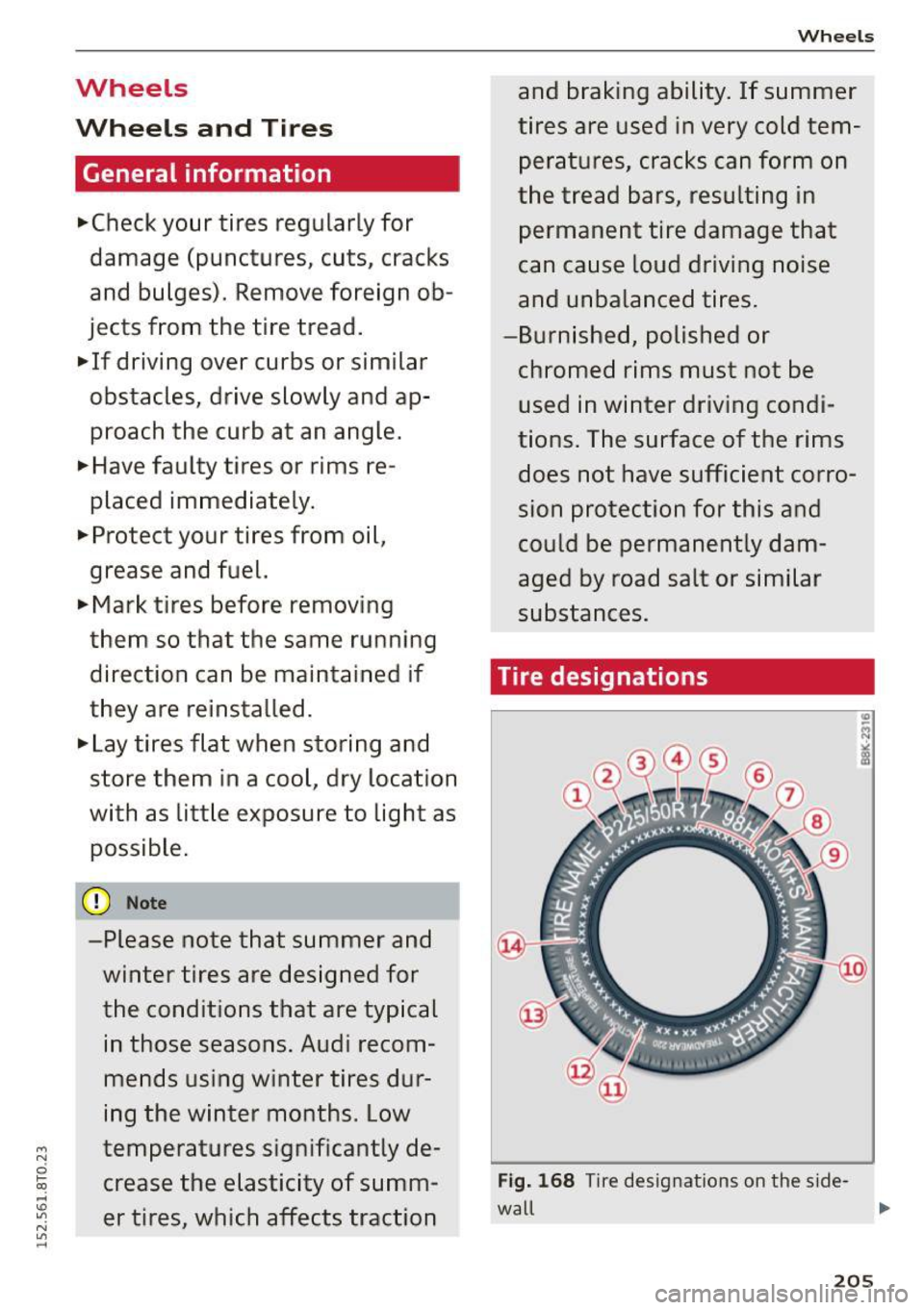
Wheels
Wheels and Tires
General information
.,.Che ck your tires regularly for
damage (punctures, cuts, cracks
and bulges). Remove foreign ob
jects from the tire tread.
.,. If driving over curbs or similar
obstacles, drive slowly and ap
proach the curb at an angle.
.,.Have faulty tires or rims re
placed immediately.
"'Protec t your tires from oil,
grease and fuel.
.,.Ma rk tires before removing
them so that the same running direction can be maintained if
they are reinstalled .
.,.Lay tires flat when storing and
store them in a cool, dry location
with as little exposure to light as
possible.
(D Note
-Please note that summer and
winter tires are designed for
the conditions that are typical
in those seasons. Audi recom
mends using winter tires dur
ing the winter months. Low
temperatures significantly de crease the elasticity of summ
er tires, which affects traction
Wheels
and braking ability. If summer
tires are used in very cold tem
peratures, cracks can form on
the tread bars, resulting in
permanent tire damage that
can cause loud driving noise
and unbalanced tires.
-Burnished, polished or
chromed rims must not be
used in winter driving condi
tions. The surface of the rims
does not have sufficient corro
sion protection for this and
could be permanently dam
aged by road salt or similar
substances.
Tire designations
Fig. 168 T ir e designations on the sid e-
wall ,..
205
Page 209 of 264
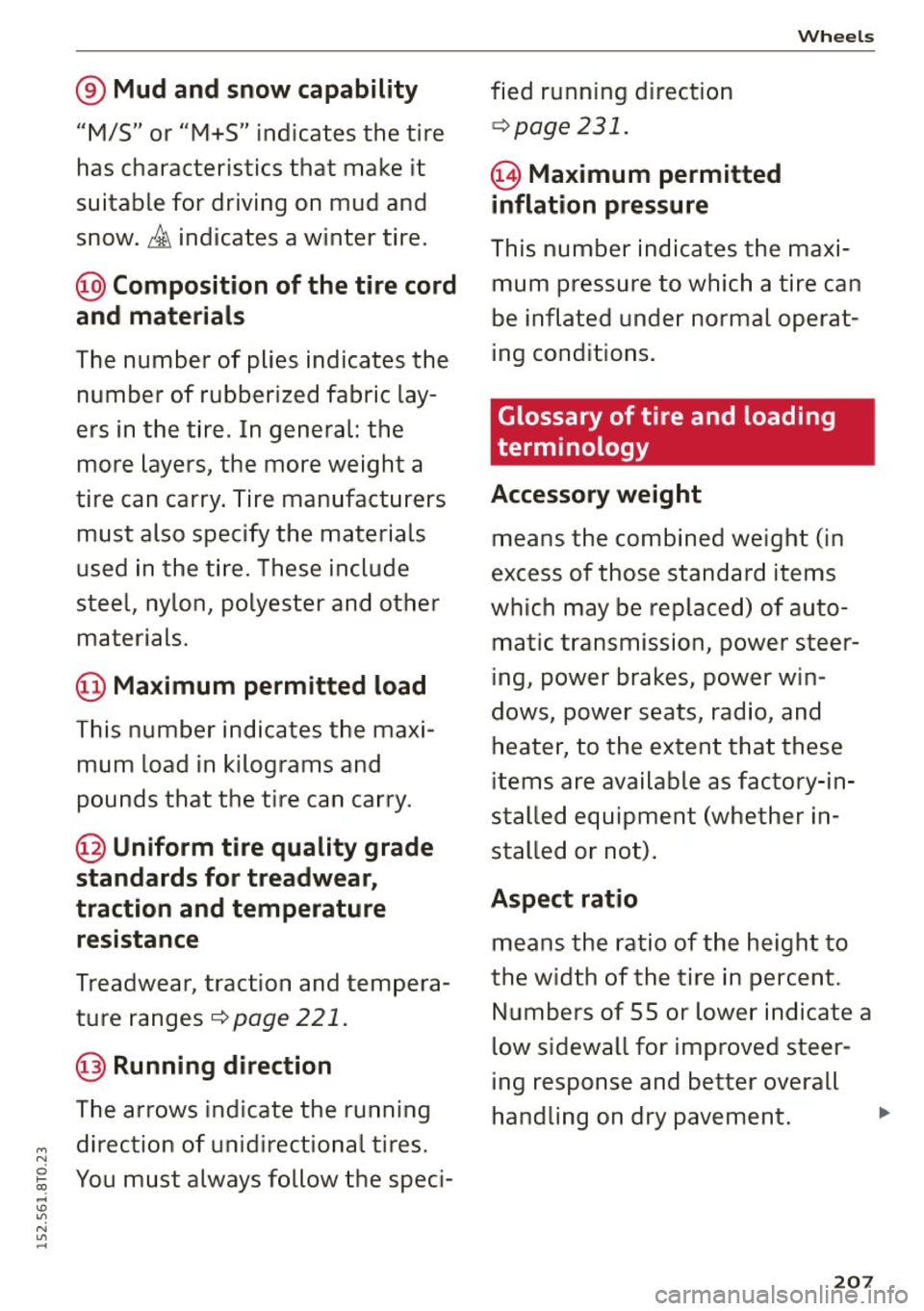
® Mud and snow capability
"M/S" or "M+S" indicates the tire
has characte ris tics that make it
suitable for driving on mud and snow .
& indica tes a winter tire.
@ Composition of the tire cord
and materials
T he number of plies indicates the
number of rubber ized fabric lay
ers in the tire . In general: the
more layers, the more weight a
tire can carry. Tire manufacturers
must also specify the mater ials
used in the ti re. These include
stee l, nylon, polyester and other
materials.
@ Maximum permitted load
This number indicates the maxi
mum load in kilograms and
pounds that the tire can carry .
@ Uniform tire quality grade
standards for treadwear,
traction and temperature resistance
Treadwear , traction and tempera
ture ranges¢
page 221.
@Running direction
The arrows ind icate the running
direction of unidirect ional tires.
You must always follow the speci- fied running direction
¢
page 231.
€3) Ma ximum permitted
inflation pressure
Whe els
This number indicates the maxi
mum pressure to which a tire can
be inflated unde r normal operat
ing conditions .
Glossary of tire and loading
terminology
Accessory weight
means the combined weight (in
excess of those standard items
which may be replaced) of auto matic transmission, power steer
ing, power brakes, power win
dows, power seats, radio, and
heater, to the extent that these
items are available as factory-in
stalled equipment (whether in
stalled or not).
Aspect ratio
means the ratio of the height to
the width of the tire in percent. Numbers of 55 or lower indicate a
low s idewall for improved steer
ing response and better overall
handling on dry pavement . .,.
207
Page 210 of 264

Wheels
Bead
means the part of the tire that is
made of steel wires, wrapped or
reinforced by ply cords and that is
shaped to fit the rim .
Bead separation
means a breakdown of the bond
between components in the bead.
Cord
means the strands form ing the
plies in the tire.
Cold tire inflation pressure
means the tire pressure recom
mended by the vehicle manufac
turer for a tire of a designated
size that has not been driven for
more than a coup le of miles (kilo
meters) at low speeds in the three
hour period before the tire pres
sure is measured or adjusted .
Curb weight
means the weight of a motor ve
hicle with standard equipment in
cluding the maximum capacity of
fuel, oi l, and coolant , air condi
tioning and additional weight of optional equipment.
E x tra load tire
means a tire des igned to operate
at higher loads and at higher in-
208
flation pressures than the corre
sponding standard tire . Extra load
tires may be identified as "XL",
"xl", "EXTRA LOAD", or "RF" on
the sidewall.
G ross A xle Weight Rating
("GAWR ")
means the load-carrying capacity
of a single axle system , measured
at the tire-ground interfaces .
Gross Vehicle Weight Rating
( "GVWR" )
means the max imum total loaded
weight of the vehicle .
Groove
means the space between two ad
jacent tread ribs .
Load rating (code )
means the max imum load that a
tire is rated to carry for a given in
flation pressure . You may not find
this information on all tires be cause it is not required by law.
Ma ximum load rating
means the load rating for a tire at
the maximum permissible infla
tion pressure for that tire .
Maximum loaded vehicle
w eight
means the sum of: ...
Page 211 of 264
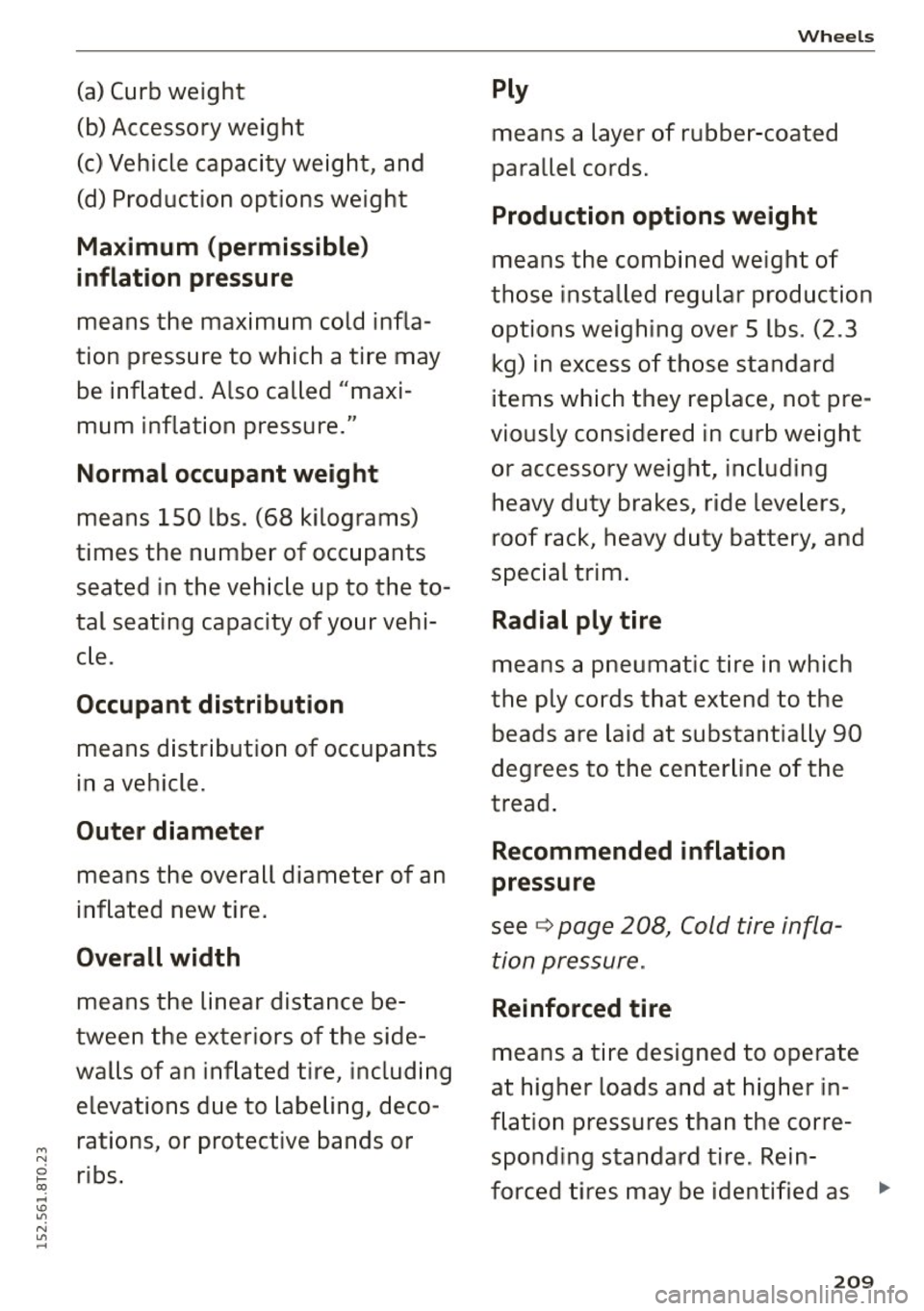
(a) Curb weight
(b) Accessory weight
(c) Vehicle capacity weight, and
(d) Product ion options weight
Maximum (permissible)
inflation pressure
means the max im um cold infla
tion pressu re to which a tire may
be inflated . Also called "ma xi
mum inflation pressure ."
Normal occupant weight
means 150 lbs . (68 kilog rams)
times the number of occupants
seated in the veh ic le up to the to
tal seating capacity of yo ur vehi
c le.
Occupant distribution
means d istr ibution of occupants
in a vehicle.
Outer diameter
means the overall diameter of an
inflated new tire .
Overall width
means the linear dis tance be
tween the exter iors of the side
walls of an inflated tire , including
elevations d ue to labe ling, deco
rations , or protective bands or
ribs .
Whee ls
Ply
means a layer of rubbe r-coated
parallel cords .
Production options weight
means the comb ined weight o f
those installed regular production
options weighing over 5 lbs . (2 .3
kg) in excess o f those s tandard
items which they re place , not pre
viously conside red in c urb weight
or accessory weight, including heavy duty brakes, ride levelers,
roof rac k, heavy d uty batte ry, and
specia l trim .
Radial ply tire
means a pneumat ic t ire in which
the ply cords that ex tend to the
beads are la id at substantially 90
degrees to the centerli ne of the
tread .
Recommended inflation
pressure
see ~ page 208, Cold tire infla
tion pressure .
Reinforced tire
means a tire designed to operate
at higher loads and at h igher in
flat ion pressures than the corre
spon ding standard tire . Rein
f orced tires may be identified as
2 0 9
Page 212 of 264
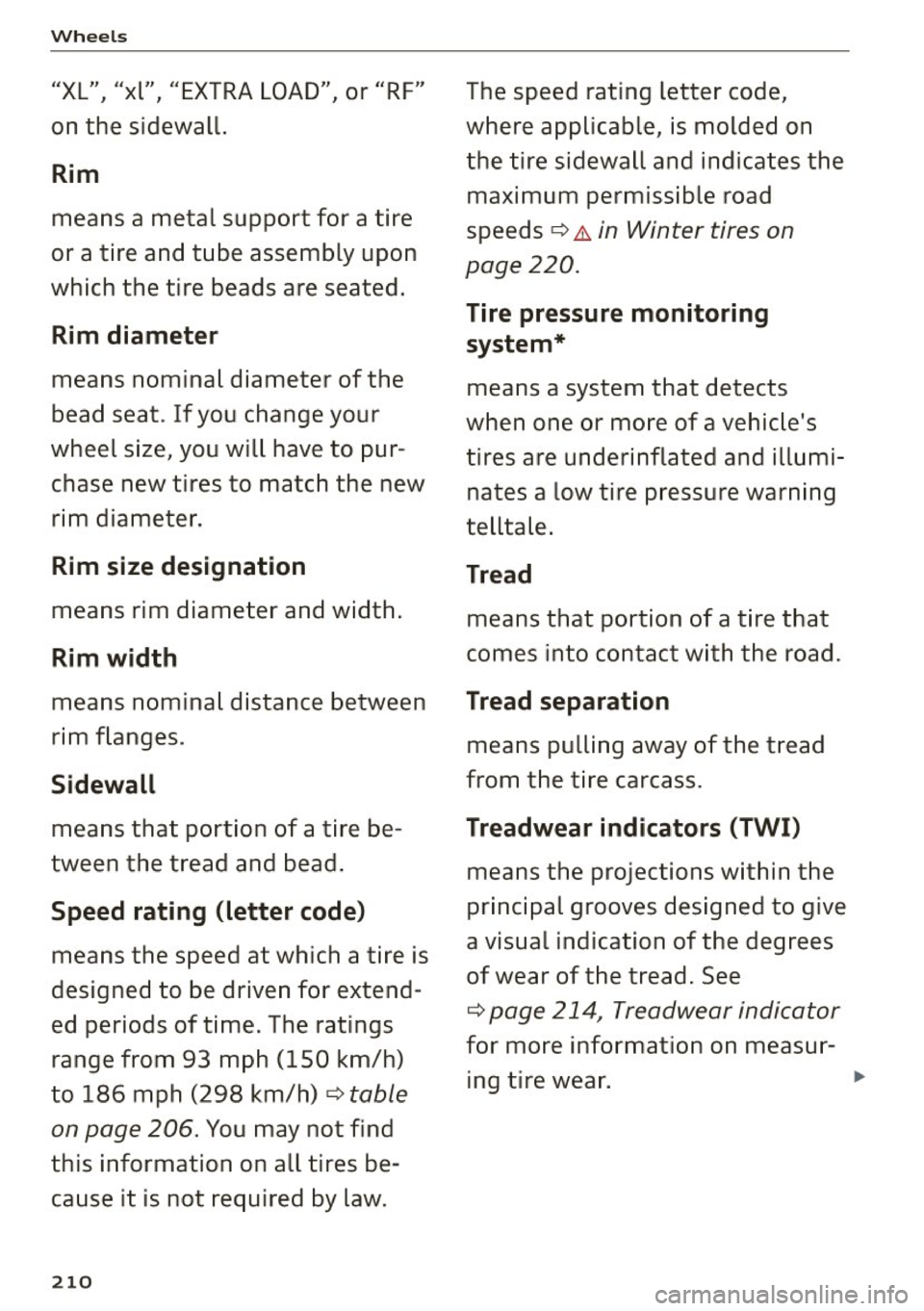
Wheels
"XL" "xl" "EXTRA LOAD" or "RF" I I I
on the sidewal l.
Rim
means a metal support for a tire
or a tire and tube assembly upon
which the tire beads are seated .
Rim diameter
means nominal diameter of the
bead seat. If you change yo ur
wheel size , you w ill have to pur
chase new tires to match the new rim diameter .
Rim size designation
means rim diameter and width.
Rim width
means nomina l distance between
rim flanges .
Sidewall
means that port ion o f a t ire be
tween the tread and bead .
Speed rating (letter code)
means the speed at which a tire is
designed to be driven for extend
ed periods of t ime. The rat ings
range from 93 mph (150 km/h)
to 186 mph (298 km/h)
¢ table
on page 206 .
You may not find
this information on all tires be
cause it is not required by la w.
2 10
The speed rating letter code ,
where applicable , is mo lded on
the tire sidewall and indicates the maximum permiss ible road
speeds
¢ .&. in Winter tires on
page 220.
Tire pressure monitoring
system*
means a system that detects
when one or mo re of a ve hic le's
tires are under inflated and illumi
na tes a low tire p ressu re warning
tellta le .
Tread
means that portion of a tire that
comes into contact w ith the road.
Tread separation
means pu lling away of the tread
from the t ire carcass.
Treadwear indicators (TWI)
means the projections wi thin the
principal grooves designed to give
a visua l indication of the deg rees
of wear of the tread . See
¢ page 214 , Treadwear indicator
for mo re information on measur
ing t ire wear.
Page 214 of 264

Wheels
Occupant loading and distri
bution for veh icle normal load
for various designated seat ing
capacit ies
Refer to the tire inflation pressure
label
c:> page 215, fig . 171 for
the number of seating positions .
Refer to the table
c:> page 216 for
the number of people that corre
spond to the vehicle normal load .
New tires or wheels
Audi recommends having all work
on tires or wheels performed by
an authorized Audi dealer or au
thorized repair facility. These fa
cilities have the proper knowledge
and are equipped with the re
quired tools and replacement
parts .
.,.N ew tires do no t yet have the
optimum adhesion properties.
D rive carefu lly and at moderate
speeds fo r the first 350 miles
(500 km) with new tires.
.,. Use tires of the same construc
tion, size (rolling circumference)
and as close to the same tread
pattern as possib le on all four
wheels.
.,. Do not replace tires individually.
At least replace both tires on the same axle at the same time .
212
.,.A udi recommends that yo u use
Aud i O rig ina l equipment tires . If
you would like to use different t ir es, please note that the ti res
may pe rform differently even if
they are the same size
c:> A -
.,. If you would li ke to equ ip your
vehicle with a tire/rim combina
t ion tha t is different from what
was installed at the facto ry, con
sult with an authorized Audi
dea ler or authorized repair facili
ty before making a purchase
¢ ,&. .
The spare tire* is different from
the regular tires installed on the
vehic le - for examp le, if winter
tires or wide t ires are insta lled -
then only use the spare tire* tem
porarily in case of eme rgency and
drive carefully wh ile it is in use. It
s h o ul d be rep laced wi th a regular
tire as soon as poss ib le .
On
all wheel drive vehic les, all
four wheels must be equipped
with tires that are the same brand
and have the same construction
and tread pattern so that the
dr ive system is not damaged by
diffe rent tire speeds. For this rea
son, in case of emergency, only
use a spa re tire* that is the same
circumference as the regular tires . .,.
Page 215 of 264
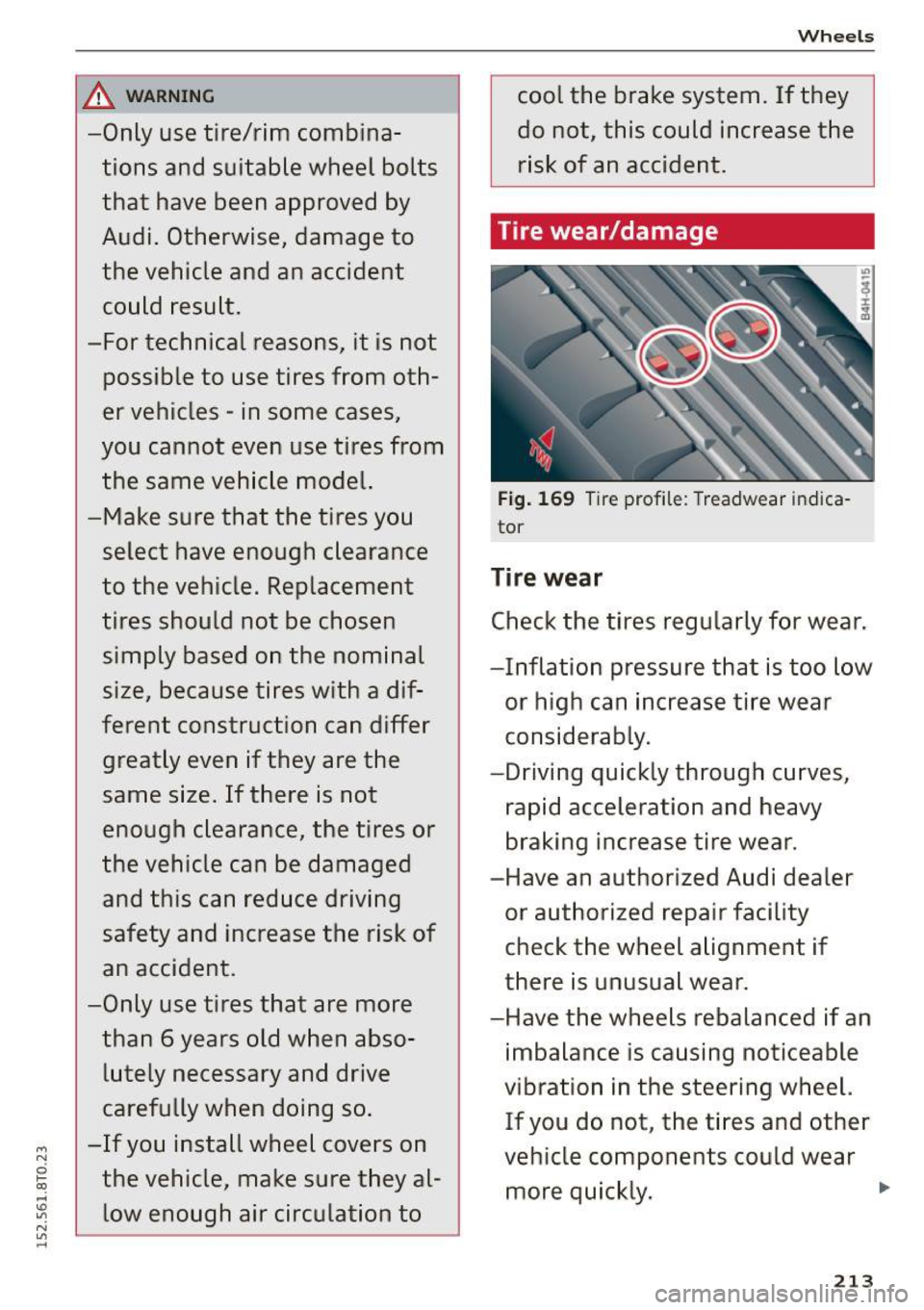
_& WARNING -
-Only use tire/rim combinations and suitable wheel bolts
that have been approved by
Audi. Otherwise, damage to
the vehicle and an accident
could result.
- For technical reasons, it is not
possible to use tires from oth
er vehicles -in some cases,
you cannot even use tires from
the same vehicle model.
- Make sure that the tires you
select have enough clearance
to the vehicle. Replacement
tires should not be chosen simply based on the nominal
size, because tires with a dif
ferent construction can differ
greatly even if they are the
same size. If there is not
enough clearance, the tires or
the vehicle can be damaged
and this can reduce driving
safety and increase the risk of
an accident.
-Only use tires that are more
than 6 years old when abso
lutely necessary and drive
carefully when doing so.
-If you install wheel covers on
the vehicle, make sure they al low enough air circulation to
Wheels
cool the brake system. If they
do not, this could increase the
risk of an accident.
Tire wear/damage
Fig. 169 Tire profile: Treadwear indica
tor
Tire wear
Check the tires regularly for wear.
- Inflation pressure that is too low
or high can increase tire wear
considerably.
-Driving quickly through curves,
rapid acceleration and heavy
braking increase tire wear.
- Have an authorized Audi dealer
or authorized repair facility
check the wheel alignment if
there is unusual wear.
-Have the wheels rebalanced if an imbalance is causing noticeable
vibration in the steering wheel. If you do not, the tires and other
vehicle components could wear more quickly.
213
...
Page 219 of 264

M N
i? co ,...., \!) 1.1'1
N 1.1'1 ,....,
Wheels
Model Tire designation Tire pressure
Engine normal load condition full load condition
(up to 2 occupants)a>
front rear front rear
PSI kPA PSI kPA PSI kPA PSI kPA
AS Coupe: 225/50 Rl 7 94H
32 220 29 200 33 230 33 230 2.0 liter All Season
4-cylinder 245/45 Rl 7 95H
All Season
32 220 29 200 33 230 33 230
245/40 Rl8 93H
33 230 29 200
35 240
35 240 All Season
255/35 Rl9 96Y
32 220 3 2 22 0 33 230 33 230 High Performance
SS Coupe: 245/40 Rl8 93H
36
250 30 210 39 270 36 250 3.0 liter All Season
6-cylinder
245/40 Rl8 93Y
High Performance
38 260 32
220 41 280
38 260
255/35 Rl9 96V
38 260 32 220
41
280 38 260 High Performance
XL= reinforced or extra load tire . It may also appear as xl, EXTRA LOAD, or RF on the tire sidewall.
a) 2 people in the front
.8, WARNING
Please note the important safe
ty precautions regarding tire pressure¢
page 215 and load
limits¢
page 217.
Tires and vehicle load limits
There are limits to the amount of load or weight that any vehicle
and any tire can carry. A vehicle
that is overloaded will not handle
well and is more difficult to stop.
Overloading can not only lead to
loss of vehicle control, but can al
so damage important parts of the
vehicle and can lead to sudden tire failure,
including a blowout
and sudden deflation that can
cause the vehicle to crash.
Your safety and that of your pas
sengers also depends on making
sure that load limits are not ex
ceeded. Vehicle load includes ev
erybody and everything in and on
the vehicle. These load limits are
technically referred to as the vehi cle's
Gross Vehicle Weight Rating
("GVWR").
The "GVWR" includes the weight
of the basic vehicle, all factory in
stalled accessories, a full tank of
fuel, oil, coolant and other fluids ""
217